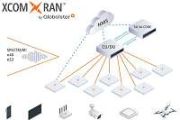The Galileo Mission Segment (GMS) will use a global network of nominally thirty Galileo Sensor Stations (GSS) to monitor the navigation signals of all satellites on a continuous basis.
It will use a comprehensive communications network using commercial satellites as well as cable connections in which each link will be duplicated for redundancy. The prime element of the GSS is the Reference Receiver. The GMS communicates with the Galileo satellites through a global network of Mission Up-Link Stations (ULS), installed at five sites, each of which will host a number of 3-metre antennas. ULSs will operate in the 5 GHz Radionavigation Satellite (Earth-to-space) band. The GMS will use the GSS network for the Orbitography Determination and Time Synchronisation (OD&TS) function, which will provide batch processing every ten minutes of all the observations of all satellites over an extended period and calculates the precise orbit and clock offset of each satellite, including a forecast of predicted variations (SISA - Signal-in-Space Accuracy) valid for the next hours. The results of these computations for each satellite will be up-loaded into that satellite nominally every 100 minutes using a scheduled contact via a Mission Up-link Station.

























































